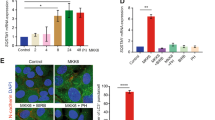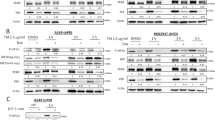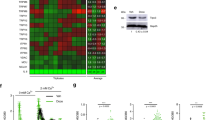Abstract
The E6AP E3 ubiquitin ligase has been linked to the regulation of cell growth and to the cellular stress response. However, the specific stress conditions that are controlled by E6AP have not been defined. An important stress condition that controls cell growth is oxidative stress, where the levels of intracellular reactive oxygen species (ROS) regulate the appropriate cellular response. Here, we describe a novel role for E6AP in the control of oxidative stress response. Cells lacking E6AP expression have reduced capacity to accumulate ROS, and oxidative DNA damage, in response to 20% cell culture oxygen levels, treatment with hydrogen peroxide and expression of oncogenic RAS. This effect of E6AP is associated with the regulation of the anti-oxidant enzyme, Prx1, a previously identified target of E6AP, and can be corrected by downregulation of Prx1 or by reconstitution of E6AP expression. Consequently, cells with compromised E6AP have impaired senescent and apoptotic response to sub-lethal and lethal doses of oxidative stress, respectively. In a xenograft model, downregulation of E6AP renders transplanted tumours refractory to growth-suppressive effects of hydrogen peroxide. Our results provide the first demonstration that E6AP is an important regulator of ROS-mediated cellular senescence and cell death.
This is a preview of subscription content, access via your institution
Access options
Subscribe to this journal
Receive 50 print issues and online access
$259.00 per year
only $5.18 per issue
Buy this article
- Purchase on Springer Link
- Instant access to full article PDF
Prices may be subject to local taxes which are calculated during checkout







Similar content being viewed by others
References
Finkel T . Signal transduction by reactive oxygen species. J Cell Biol 2011; 194: 7–15.
Finkel T, Holbrook NJ . Oxidants, oxidative stress and the biology of ageing. Nature 2000; 408: 239–247.
D’Autreaux B, Toledano MB . ROS as signalling molecules: mechanisms that generate specificity in ROS homeostasis. Nat Rev Mol Cell Biol 2007; 8: 813–824.
Bertram C, Hass R . Cellular responses to reactive oxygen species-induced DNA damage and aging. Biol Chem 2008; 389: 211–220.
Egler RA, Fernandes E, Rothermund K, Sereika S, de Souza-Pinto N, Jaruga P et al. Regulation of reactive oxygen species, DNA damage, and c-Myc function by peroxiredoxin 1. Oncogene 2005; 24: 8038–8050.
Neumann CA, Krause DS, Carman CV, Das S, Dubey DP, Abraham JL et al. Essential role for the peroxiredoxin Prdx1 in erythrocyte antioxidant defence and tumour suppression. Nature 2003; 424: 561–565.
Jones FS, Meech R, Edelman DB, Oakey RJ, Jones PL . Prx1 controls vascular smooth muscle cell proliferation and tenascin-C expression and is upregulated with Prx2 in pulmonary vascular disease. Circ Res 2001; 89: 131–138.
Zuckerman V, Wolyniec K, Sionov RV, Haupt S, Haupt Y . Tumour suppression by p53: the importance of apoptosis and cellular senescence. J Pathol 2009; 219: 3–15.
Lowe SW, Cepero E, Evan G . Intrinsic tumour suppression. Nature 2004; 432: 307–315.
Lu T, Finkel T . Free radicals and senescence. Exp Cell Res 2008; 314: 1918–1922.
Parrinello S, Samper E, Krtolica A, Goldstein J, Melov S, Campisi J . Oxygen sensitivity severely limits the replicative lifespan of murine fibroblasts. Nat Cell Biol 2003; 5: 741–747.
Busuttil RA, Rubio M, Dolle ME, Campisi J, Vijg J . Oxygen accelerates the accumulation of mutations during the senescence and immortalization of murine cells in culture. Aging Cell 2003; 2: 287–294.
Yoshizaki K, Fujiki T, Tsunematsu T, Yamashita M, Udono M, Shirahata S et al. Pro-senescent effect of hydrogen peroxide on cancer cells and its possible application to tumor suppression. Biosci Biotechnol Biochem 2009; 73: 311–315.
Chen Q, Ames BN . Senescence-like growth arrest induced by hydrogen peroxide in human diploid fibroblast F65 cells. Proc Natl Acad Sci USA 1994; 91: 4130–4134.
Chen QM, Bartholomew JC, Campisi J, Acosta M, Reagan JD, Ames BN . Molecular analysis of H2O2-induced senescent-like growth arrest in normal human fibroblasts: p53 and Rb control G1 arrest but not cell replication. Biochem J 1998; 332: 43–50.
Bladier C, Wolvetang EJ, Hutchinson P, de Haan JB, Kola I . Response of a primary human fibroblast cell line to H2O2: senescence-like growth arrest or apoptosis? Cell Growth Differ 1997; 8: 589–598.
Lee AC, Fenster BE, Ito H, Takeda K, Bae NS, Hirai T et al. Ras proteins induce senescence by altering the intracellular levels of reactive oxygen species. J Biol Chem 1999; 274: 7936–7940.
Weyemi U, Lagente-Chevallier O, Boufraqech M, Prenois F, Courtin F, Caillou B et al. ROS-generating NADPH oxidase NOX4 is a critical mediator in oncogenic H-Ras-induced DNA damage and subsequent senescence. Oncogene 2012; 31: 1117–1129.
Wolyniec K, Wotton S, Kilbey A et al. RUNX1 and its fusion oncoprotein derivative, RUNX1-ETO, induce senescence-like growth arrest independently of replicative stress. Oncogene 2009; 28: 2502–2512.
Leikam C, Hufnagel A, Schartl M, Meierjohann S . Oncogene activation in melanocytes links reactive oxygen to multinucleated phenotype and senescence. Oncogene 2008; 27: 7070–7082.
Beaudenon S, Huibregtse JM . HPV E6, E6AP and cervical cancer. BMC Biochem 2008; 9: S4.
Hengstermann A, Linares LK, Ciechanover A, Whitaker NJ, Scheffner M . Complete switch from Mdm2 to human papillomavirus E6-mediated degradation of p53 in cervical cancer cells. Proc Natl Acad Sci USA 2001; 98: 1218–1223.
Howley PM . Warts, cancer and ubiquitylation: lessons from the papillomaviruses. Trans Am Clin Climatol Assoc 2006; 117: 113–126.
Scheffner M, Werness BA, Huibregtse JM, Levine AJ, Howley PM . The E6 oncoprotein encoded by human papillomavirus types 16 and 18 promotes the degradation of p53. Cell 1990; 63: 1129–1136.
Matentzoglu K, Scheffner M . Ubiquitin ligase E6-AP and its role in human disease. Biochem Soc Trans 2008; 36: 797–801.
Levav-Cohen Y, Wolyniec K, Alsheich-Bartok O, Chan AL, Woods SJ, Jiang YH et al. E6AP is required for replicative and oncogene-induced senescence in mouse embryo fibroblasts. Oncogene 2012; 31: 2199–209.
Nasu J, Murakami K, Miyagawa S, Yamashita R, Ichimura T, Wakita T et al. E6AP ubiquitin ligase mediates ubiquitin-dependent degradation of peroxiredoxin 1. J Cell Biochem 2010; 111: 676–685.
Vafa O, Wade M, Kern S, Beeche M, Pandita TK, Hampton GM et al. c-Myc can induce DNA damage, increase reactive oxygen species, and mitigate p53 function: a mechanism for oncogene-induced genetic instability. Mol Cell 2002; 9: 1031–1044.
Chen Q, Fischer A, Reagan JD, Yan LJ, Ames BN . Oxidative DNA damage and senescence of human diploid fibroblast cells. Proc Natl Acad Sci USA 1995; 92: 4337–4341.
van Loon B, Markkanen E, Hubscher U . Oxygen as a friend and enemy: How to combat the mutational potential of 8-oxo-guanine. DNA Repair 2010; 9: 604–616.
Bacsi A, Chodaczek G, Hazra TK, Konkel D, Boldogh I . Increased ROS generation in subsets of OGG1 knockout fibroblast cells. Mech Ageing Dev 2007; 128: 637–649.
Bonner WM, Redon CE, Dickey JS, Nakamura AJ, Sedelnikova OA, Solier S et al. GammaH2AX and cancer. Nat Rev Cancer 2008; 8: 957–967.
d’Adda di Fagagna F . Living on a break: cellular senescence as a DNA-damage response. Nat Rev Cancer 2008; 8: 512–522.
Ben-Yoseph O, Ross BD . Oxidation therapy: the use of a reactive oxygen species-generating enzyme system for tumour treatment. Br J Cancer 1994; 70: 1131–1135.
Nathan CF, Cohn ZA . Antitumor effects of hydrogen peroxide in vivo. J Exp Med 1981; 154: 1539–1553.
Sugiura K . Effect of hydrogen peroxide on transplanted rat and mouse tumours. Nature 1958; 182: 1310–1311.
Vurusaner B, Poli G, Basaga H . Tumor suppressor genes and ROS: complex networks of interactions. Free Radic Biol Med 2012; 52: 7–18.
Ramamoorthy S, Tufail R, Hokayem JE, Jorda M, Zhao W, Reis Z et al. Overexpression of ligase defective E6-associated protein, E6-AP, results in mammary tumorigenesis. Breast Cancer Res Treat 2012; 132: 97–108.
Cha MK, Suh KH, Kim IH . Overexpression of peroxiredoxin I and thioredoxin1 in human breast carcinoma. J Exp Clin Cancer Res 2009; 28: 93.
Serrano M, Lin AW, McCurrach ME, Beach D, Lowe SW . Oncogenic ras provokes premature cell senescence associated with accumulation of p53 and p16INK4a. Cell 1997; 88: 593–602.
Cao J, Schulte J, Knight A, Leslie NR, Zagozdzon A, Bronson R et al. Prdx1 inhibits tumorigenesis via regulating PTEN/AKT activity. EMBO J 2009; 28: 1505–1517.
Brummelkamp TR, Bernards R, Agami R . Stable suppression of tumorigenicity by virus-mediated RNA interference. Cancer Cell 2002; 2: 243–247.
Brummelkamp TR, Bernards R, Agami R . A system for stable expression of short interfering RNAs in mammalian cells. Science 2002; 296: 550–553.
Acknowledgements
We thank Scott Lowe, Martin Scheffner and Ikuo Shoji who generously provided plasmids. This work was supported by grants from the National Health and Medical Research Council (NHMRC) of Australia to YH (NHMRC #509196, #509197, #1026990, #1026988), by a grant from the Cancer Council Victoria, and by the VESKI award. YH is NHMRC Senior Research Fellow.
Author information
Authors and Affiliations
Corresponding author
Ethics declarations
Competing interests
The authors declare no conflict of interest.
Additional information
Supplementary Information accompanies the paper on the Oncogene website
Supplementary information
Rights and permissions
About this article
Cite this article
Wolyniec, K., Levav-Cohen, Y., Jiang, YH. et al. The E6AP E3 ubiquitin ligase regulates the cellular response to oxidative stress. Oncogene 32, 3510–3519 (2013). https://doi.org/10.1038/onc.2012.365
Received:
Revised:
Accepted:
Published:
Issue Date:
DOI: https://doi.org/10.1038/onc.2012.365
Keywords
This article is cited by
-
Elevated ROS levels during the early development of Angelman syndrome alter the apoptotic capacity of the developing neural precursor cells
Molecular Psychiatry (2023)
-
Siah2–GRP78 interaction regulates ROS and provides a proliferative advantage to Helicobacter pylori-infected gastric epithelial cancer cells
Cellular and Molecular Life Sciences (2022)
-
Induction of E6AP by microRNA-302c dysregulation inhibits TGF-β-dependent fibrogenesis in hepatic stellate cells
Scientific Reports (2020)
-
Identifying the ubiquitination targets of E6AP by orthogonal ubiquitin transfer
Nature Communications (2017)
-
ΔNp63 targets cytoglobin to inhibit oxidative stress-induced apoptosis in keratinocytes and lung cancer
Oncogene (2016)



